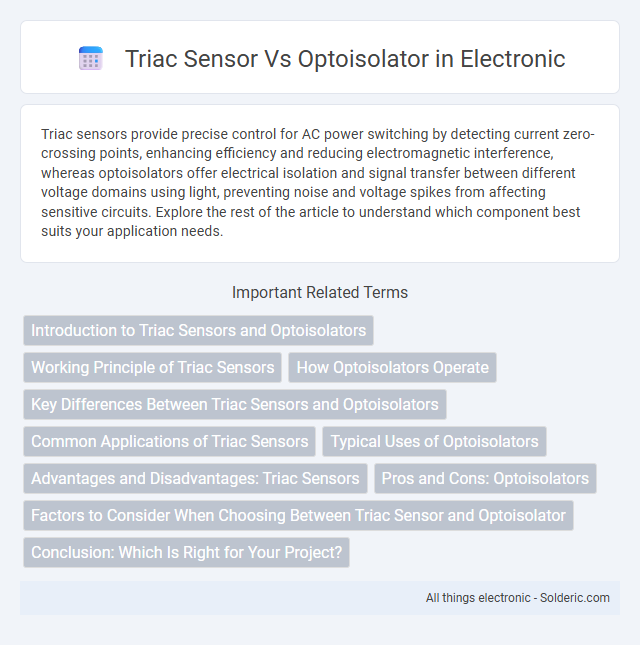Triac sensors provide precise control for AC power switching by detecting current zero-crossing points, enhancing efficiency and reducing electromagnetic interference, whereas optoisolators offer electrical isolation and signal transfer between different voltage domains using light, preventing noise and voltage spikes from affecting sensitive circuits. Explore the rest of the article to understand which component best suits your application needs.
Comparison Table
| Feature | Triac Sensor | Optoisolator |
|---|---|---|
| Function | Detects AC current phase and switching | Provides electrical isolation and signal transfer |
| Isolation Type | None (direct AC connection) | Optical isolation (high voltage isolation) |
| Input Signal | AC voltage or current | Electrical signal (often DC or low voltage AC) |
| Output Signal | Phase information, zero-cross detection | Electrical signal with galvanic isolation |
| Applications | AC load control, phase angle measurement, zero crossing detection | Signal isolation in microcontrollers, switching power supplies, communication interfaces |
| Response Time | Moderate - depends on AC frequency | Fast - typically microseconds to nanoseconds |
| Voltage Rating | High - suitable for mains voltage (110-240V AC) | Variable - depends on optocoupler specs, isolation voltage typically 3-5 kV |
| Installation | Requires direct AC connection and heat dissipation consideration | PCB mounted with low voltage inputs and isolated outputs |
Introduction to Triac Sensors and Optoisolators
Triac sensors detect alternating current (AC) voltage and control AC loads by triggering a TRIAC, enabling precise switching in AC circuits. Optoisolators, also known as optocouplers, provide electrical isolation by transmitting signals through light between input and output, protecting low-voltage circuits from high-voltage spikes. Both components are essential in industrial automation and power electronics for controlling and isolating AC power devices safely and efficiently.
Working Principle of Triac Sensors
Triac sensors operate by detecting the phase of the AC signal and triggering the triac to control power flow in AC circuits, allowing precise switching without mechanical contacts. These sensors monitor current or voltage zero crossings to synchronize the triac firing angle, enabling efficient dimming or motor control. Your application benefits from faster switching times and improved electrical noise immunity compared to optoisolators, which rely on light signals for isolation but do not control high-power loads directly.
How Optoisolators Operate
Optoisolators operate by using an LED to emit light that activates a photodetector, such as a phototransistor or photodiode, isolating input and output circuits electrically. This optical coupling enables safe signal transmission without direct electrical contact, protecting sensitive components from high voltage spikes. Your control system benefits from improved noise immunity and electrical isolation, essential for reliable switching and signal conditioning in mixed-voltage environments.
Key Differences Between Triac Sensors and Optoisolators
Triac sensors primarily detect and control AC power by switching loads in response to signal inputs, whereas optoisolators provide electrical isolation between input and output using light to transfer signals without direct electrical contact. Triac sensors are designed for AC load switching with high voltage tolerance, making them suitable for dimmers and motor controls, while optoisolators are ideal for protecting sensitive circuitry from voltage spikes and noise in signal transmission. The key differences lie in their function: triac sensors handle power regulation directly, whereas optoisolators focus on signal isolation and noise immunity.
Common Applications of Triac Sensors
Triac sensors are commonly used in AC power control applications such as dimming lights, regulating motor speeds, and managing heating elements. These sensors provide reliable switching capabilities by detecting zero-crossing points in AC signals, ensuring smooth operation and minimal electrical noise. Unlike optoisolators, which primarily isolate signals between different circuit sections, Triac sensors directly control high-voltage AC loads in home automation and industrial systems.
Typical Uses of Optoisolators
Optoisolators are commonly used in signal isolation between high-voltage circuits and low-voltage control systems, ensuring electrical safety and noise reduction in applications like microcontroller interfacing, telecommunication equipment, and industrial automation. They protect sensitive components by enabling voltage level shifting while preventing ground loops and transient voltage spikes. Your designs benefit from enhanced reliability and durability when using optoisolators in environments requiring precise electrical isolation and signal integrity.
Advantages and Disadvantages: Triac Sensors
Triac sensors offer advantages such as efficient AC load switching, minimal power consumption, and isolation from high voltage circuits, making them ideal for dimmer switches and motor controls. However, their disadvantages include sensitivity to noise, limited usage with DC loads, and possible false triggering due to voltage spikes. Your choice should consider these factors to determine if a triac sensor fits the application's switching and isolation requirements.
Pros and Cons: Optoisolators
Optoisolators provide excellent electrical isolation, protecting your circuits from high voltages and noise interference, which enhances overall device safety and reliability. They have slower switching speeds and limited current handling compared to Triac sensors, making them less suitable for high-power or AC load applications. Their compact size and low power consumption make optoisolators ideal for signal isolation in low-voltage and sensitive electronic environments.
Factors to Consider When Choosing Between Triac Sensor and Optoisolator
When choosing between a Triac sensor and an optoisolator, factors such as isolation voltage, response time, and application requirements are critical. Triac sensors are ideal for AC load switching with high voltage tolerance and zero-cross detection, while optoisolators excel in providing electrical isolation and fast response in low voltage DC signal interfacing. Consider load type, switching frequency, and noise immunity to optimize performance and ensure system reliability.
Conclusion: Which Is Right for Your Project?
Triac sensors excel in controlling AC power directly, making them ideal for dimming lights and motor speed regulation in your home automation or industrial projects. Optoisolators provide superior electrical isolation, protecting sensitive microcontrollers in low-voltage signal interfacing and noisy environments. Choosing between a triac sensor and an optoisolator depends on whether your project prioritizes power control efficiency or robust signal isolation.
Triac sensor vs optoisolator Infographic

 solderic.com
solderic.com